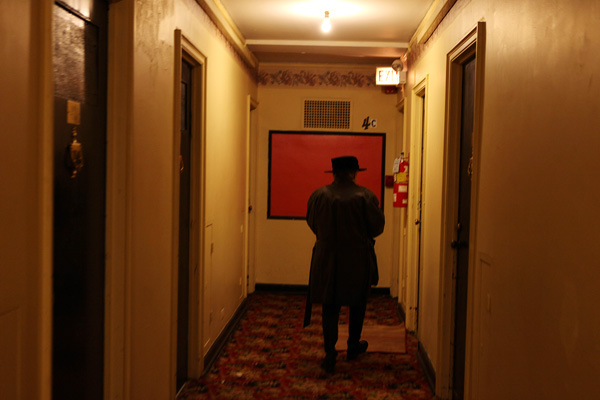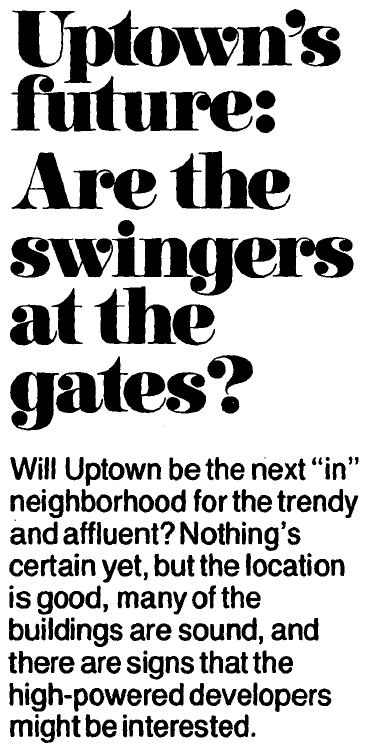
Photo: Abel Uribe/Chicago Tribune
Lawrence House SRO in Uptown, May 9, 2012
Today WBEZ's Odette Yousef has a piece on the closing of the Chateau Hotel in Uptown [update: I'm told by many reliable sources that the Chateau is in Lakeview]; three tenants had been hanging on to their units in the 138-unit building. Now they've been ordered out by a judge, and the building will be renovated. It's one of many SRO—single room occupancy—hotels that have come down in recent years:
The 46th Ward had 14 licensed SROs in 2012 — at least twice as many as any other ward. About one quarter of the city’s SROs have been in four of the North Side lakefront wards alone: (wards 44, 46, 48, and 49). But on the whole, the number of SROs in Chicago has declined noticeably in the last five years. In 2008 there were 106 licensed SROs. Today, there are 81.
As local reporter and activist Bob Zuley told Megan Cottrell, not all the affordable SRO housing is disappearing; some SROs will be used for similar purposes, but for specific communities, like housing for the mentally ill or female ex-offenders. Some of the disappearing SROs are being turned into SRO-like condos, including "micro-units," sort of a boutique SRO with apartments as small as 275 square feet and renting for $700:
It’s an ambitious plan, particularly for an area that, despite crime stats on par with Lakeview, can’t seem to shake its rough-around-the-edges rep. The FLATS team is aware of the stigma. “I think the minute you walk into our building you know you’ve arrived at someplace very different from what you’ve been told has been Uptown all these years,” Michael says. “Uptown is an up-and-coming area,” Kim adds. “You have development pressure between Lakeview and Andersonville, and the floodgates are opening.”
It's an old dream for the neighborhood. As Alison Fischer writes in AREA Chicago, Uptown's SROs were originally meant to be small yet luxurious rooms for swinging singles and young couples, offering "a cosmopolitan lifestyle free from the drudgery of housekeeping and long commutes" with space-saving Murphy beds serviced by maid and linen service. The tiny apartments were supposed to be a feature, as residents were meant to be out and social. It's a vision similar to what FLATS envisions for Uptown in the 21st century.
Plus ça change.

That's a Tribune headline from September 1974, when real-estate experts were predicting "a population drift from the Mid-North neighborhoods, which are getting too expensive for the next wave of hip young house-hunters and groovy merchants." Not that that was anything new at the time, either.
Uptown is an area that all sorts of government agencies love to tinker with, and it has wallowed in confusion for a long time. "There were so many proposals flying around, here in Washington, that everybody was getting into the act and the developers were getting scared away," says James Cain. "Everybody was waiting for the Big Brother money to come thru and do the whole job…. I heard developers say 'I don't want to touch that area, it's a hot potato. They're going to end up building 34 100-story high rises or something, and there I am with my little six-flat. That sort of talk was going on for 10 years.
What made it possible in the minds of developers was that SRO housing was already in precipitous decline in the mid-1970s: "in Chicago, where the most systematic research on SRO decline has been conducted, 81 percent of the city's stock was lost between 1960 and 1980." Worsening the issue was the nationwide trend of deinstitutionalization; during that time 7,000 mentally ill former patients were moved into Uptown in one year alone. Truman College, conceived in the late 1960s and completed in 1976, was supposed to be a hub of urban renewal, playing the same (not entirely successful) role that UIC played west of the Loop—the destruction of SRO and slum housing in the Loop and its environs also swelled Uptown's transient population, making it even more of a political and economic target.
Then fires—some intentional arson-for-profit—began burning down the neighborhood's buildings, including its decaying residential hotels; "for years the term most used to describe Uptown and Edgewater is 'arson-plagued,'" the Tribune's Robert Benjamin wrote in 1981. 13 people died in two separate fires on one day, December 29, 1979. The 1981 Royal Beach Hotel fire killed 19 of the building's 150 residents. It wasn't an arson; it had passed fire inspection, but that didn't include the building's electrical system, which started the blaze.
SRO housing declined further still in the next decade; in 1986, the Tribune reported that the city had lost 17,000 SRO units since 1976, including 3,000 alone in the West Loop space that now houses the Presidential Towers. What fire didn't take away, politics and a fraying social-safety net did: "A public aid change further hurt many residents in 1980. General assistance–the basic allotment for welfare recipients–was cut from $200 to $144 a month."
That left only 11,500 units, which suggests how large the SRO population was prior to 1960. But despite the slow disappearance of SROs, Uptown has had a housing-activist base to slow it down. In 1988, Eugene Sawyer christened the "Harold Washington SRO," built with $260,000 in donations and a $740,000 loan at zero percent interest from the city. It still exists, known as the Harold Washington Apartments, and was renovated at a cost of $68 million, bringing it up to LEED standards. The year it was rehabbed in the shell of the old Moreland Hotel, one of its developers, Jean Butzen, predicted that at the rate of destruction—60 percent of SROs in 25 years—it would all be gone by 1995. What's surprising is not that they continue to come down in Uptown; it's that they've survived.


